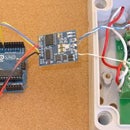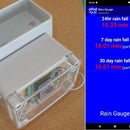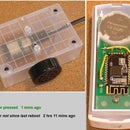Introduction: Android Controlled Lights and Power, PfodDevice for Arduino
Update: See Andriod/Arduino for Beginners - Design Custom Andriod menus to switch Arduino outputs on and off. Absolutely No Programming Required for an alternative that does not require any programming at all.
==================================================================
Control your Lights and Power from your AndriodTM mobile using Arduino.
NO Android Programming required. No Soldering required.
Power wiring required.
See www.pfod.com.au for more Android controlled example projects
Note: this instructable has been updated to replace the discontinued relay shield with Relay shield V2.0 .
Safety Warning
This project will be wired into the 110V-240V main wiring to switch devices on and off from your Android mobile. 110V-240V Mains is lethal and after you have put this project together, the wiring to the mains power should only be done by a qualified electrician.
Introduction
You can give each relay your own personal name by editing the Arduino code as shown below. No Android programming is required.
An electrician should mount the project in a suitable insulated box and wire the four relays across the switches of the lights and/or power points you want to control.
This project is in three parts.
i)The basic control of 4 switches, called switch 1, switch 2, switch 3 and switch 4. This is what you get from the Quick Start.
ii) Customizing the names of your switches to give them meaningful names.
iii) Making one of the switches a Garage Door opener and the other three the Outside Light, Garage Light and Hall Light (shown above) or what ever name your want.
No Android programming is required to make and any of these three versions. Simple changes to the Arduino code completely controls what options are presented on the user's mobile.
By adding a bluetooth module and a small amount of code to make your Arduino device a pfodDevice, you can control your Arduino project from your Android mobile, in this case the Arduino turns relays on or off and pulses a relay which is in parallel with the garage door manual push button to open and close it.
pfodDevice's are controlled by a pfodApp. Imagine HTML re-designed for micros with short simple messages each less than 255 bytes to describe the pages. The pfodApp is the micro-browser and the pfodDevice is the micro-server. When the pfodApp running on your Andriod mobile connects, via bluetooth, to your Arduino, the pfodApp sends the request {.} which asks for the pfodDevice's main menu. The pfodDevice return a short messsage (max 255 bytes) which the pfodApp renders to give the user choices that control the pfodDevice. When your user selects a button or menu item, the pfodApp sends the associated command back to your Arduino to execute that function. Commands are typically a single character enclosed by { }. Your Arduino code extracts the command character from this message, using the simple parser below, and executes the associated function.
That's all there is to it. No Android programming is required and the only additional programming you need in your Arduino is the small command parser. All the text and prompts displayed on the Android mobile are completely controlled by the code in the Arduino. The same Andriod pfodApp can control any Arduino or other micro-controller which has been coded as a pfodDevice. If you want to test out how the pfod micro-pages will look on pfodApp, then set up a bluetooth serial connection to your pc as described here and type the micro-pages into the terminal window and see how pfodApp displays them. This also lets you see what messages the pfodApp will return for various user inputs.
As well as navigation buttons and multiple levels of menus, which the parser below handles, the pfod Specification also supports user input such as numbers, text and multi and single selection lists. A slightly larger parser is required to parse user input, see Remote Controlled LCD Display.
The pfod Specification has been designed to keep the micro-controller code (the Arduino code) simple. The micro-controller does not and should not remember the user's navigation history, the Android pfodApp does all that. The micro-controller should simply execute the function associated with the command it is sent and return a result message (often just {} ). See the pfod Specification for all the details and examples.
The Step 1 is the Quick Start which will give you 4 Android controlled switches.
Step 1: Android Controlled Lights and Power - QuickStart
1) Android Controlled Lights and Power – Quick Start
This quick start will give you control of 4 switches from your Android mobile.
The switches are named Switch 1, Switch 2, Switch 3 and Switch 4 and correspond to the Relay board terminal blocks 1,2,3 and 4.
The Android pfodApp shows the current state of each switch, ON or OFF. (The next step in this tutorial shows you how to set your own names for the switches.)
Here is the parts list of what you need and where I purchased my parts, it also contains alternative US sources for parts I purchased in Australia.
Quick Start
1) Install the Arduino IDE from http://arduino.cc/en/Guide/HomePage
2) Open a new File and copy this code to the IDE window, plug in the Arduino Uno via the usb cable and program it. Then un-plug the USB cable.
3) Set the switches on the Bluetooth board. Set the 3V/5V switch to 5V and set the To Board/To FT232 switch to the To Board position.
4) Plug the three boards together Arduino, Bluetooth, Relay board. Make sure the pins all line up correctly..
5) Plug the USB Wall Charger into the Arduino board via the USB cable, so that it will power all three boards.
6) Download the pfodApp to your Android mobile.
7) Pair your mobile with the Bluetooth shield and setup a pfod connection called Lights and Power, as described here.
8) Start pfodApp and click the Switch 1 to 4 buttons to turn the relays on and off. Check between COM and NC terminals for terminals 1 to 4 with a multi-meter on Ohms.
9) Have an electrician install in a mains rated box and wire the relays to the lights/power points you want to control. If you want to customize the names of the switches proceed to the next step before installing.
10) Finished.
The next step will show you how to edit the Arduino code to give the switches your own names.
Step 2: Android Controlled Lights and Power - Name the Switches
The quick start build just used generic names of Switch 1 to Switch 4. However it is easy to give the switches your own unique names.
Open the code in the Arduino IDE and edit the Switch Name text to whatever you want. For example here I have named Switch 2,3 and 4 as “Front Light”, “Garage Light” and “Hall Light” and saved the file as FrontLights.
Switch 1 is not used in this example so to prevent it from being displayed by the Android mobile pfodApp, I commented out the code that adds that menu item to the message sent to the mobile.
The completed FrontLights code is here. Then when you connect your Android mobile pfodApp, it displays the screen show in this step.
The next step will add a Garage Door opener to the project
Step 3: Android Controlled Lights and Power -- Garage Door Opener
Finally here is the code that combines a garage door opener with the control of the front lights. It combines the Android controlled Garage Door opener, which uses relay 1, with the Front Lights code from part 2).
That is the final example code. (Note: the code was updated 21st March 2013 to improve timer reliablity, see How to write Timings and Delays in Arduino for the details)
pfodApp Debug Screen (not normally seen by users)
The other 3 screen shots show the pfodApp debug screen. The user does not normally see this screen. It is accessed from the mobile's menu button. This pfodApp debug screen shows all the communication between the pfodApp and pfodDevice. Messages with < are send by the pfodApp, messages with > are received by the pfodApp from the pfodDevice.
Next I will discuss how the Android pfodApp displays the relay states and controls the relays. All the code examples above are complete in themselves, no libraries are needed. However there are libraries available for the pfodDevice command parser if you want to use them. Examples of using these libraries are given in Garage Door Remote and in Remote Controlled LCD/LED Display. The Arduino pfod libraries are available here.
Coding the Arduino to be a pfodDevice.
The pfodDevice Command Parser
In order to communicate with the pfodApp on your Android mobile, the Arduino needs to be coded as a pfodDevice. The pfod Specification details what functionality must be supported in order to be a pfodDevice. As you would expect the requirements for the pfodDevice are minimal
The pfodDevice is required to:-
1. Respond to all messages, even unrecognised ones, with a reply message. This reply message can be the Empty message, {}
2. Respond to the GetMainMenu request, {.} , with a main menu or navigation input of top level functionality or, less commonly, with one of other messages:- SingleSelectionList, MultiSelectionList, UpdateMenu StreamingRawData, StringInput, NumericInput or the Empty message {}
3. Ignore messages whose length exceeds 255 bytes, including the start and end { } bytes.
4. If the connection is half-duplex then the messages from the pfodApp to the pfodDevice take precedence over, and can interrupt, streaming raw data coming from the pfodDevice.
As an example we will look at the pfodDevice code for the combined garage door opener and lights control.
First the pfodDevice needs to respond to the {.} message that the pfodApp on your Andriod mobile sends when it connects. This requests the pfodDevice's main menu. In this case we want to display 4 buttons (menu items), with the names of the switches and their current state, On or Off.
Each of these buttons has a unique command associated with it which is not displayed to the user. When the user selectes that menu item, the associated command is send back to the pfodDevice (Arduino Uno) to be executed. In this case the commands '1', '2', '3' and '4' are used for the each of the 4 relay. So a typical main menu message would look like the second screen shown
This is a screen shot from the debug screen of the pfodApp. The pfodApp debug screen is accessed from the mobiles menu button. When the pfodApp connected to the Arduino pfodDevice, the pfodApp send the {.} message to request the pfodDevice's main menu. The pfodDevice parser parses the Cmd: . and the Adruino code prints out the result. The pfodApp on the Android mobile ignores this text since it is not contained within pfod message start and end chars, { } . The pfodDevice then returnes its main menu
{.Press to switch on/off|1~GarageDoor\nOpen/Close|2~Front Light\nis OFF|3~Garage Light\nis OFF|4~Hall Light\nisOff}
where \n starts a new line. The {. indicates that this message should be displayed as a list of menu items, buttons. The next 4 sections between | | define each menu item. Each menu item is made up of the command ~ display text. See the pfodSpecification for a detailed description of this menu message. First part is the command to be sent back when this menu item is selected and then the text to display. So for example 2~Front Light\nis OFF sets 2 as the command for this menu button and set the text as
Front Light
is Off
When the user selects this menu item, the pfodApp send the associated command 2, in the message {2}, to the pfodDevice. The pfodDevice command parser parsers the command and activates the relay and sends back an updated menu to display to the user, showing that the Front Light is now ON.
When the Garage Door Open/Close button is pressed the pfodApp sends the msg {1} to the pfodDevice, which parse the message and pulses the relay connected to the garage door push button to open/close the door.
Notice in this case the Arduino code prints when it starts and ends the pulsing of the relay. Again the pfodApp ignores this extra text as it is not contained within the pfod message start and end characters { } . See Android controlled Garage Door opener for a more details on the Garage Door pulse code.






